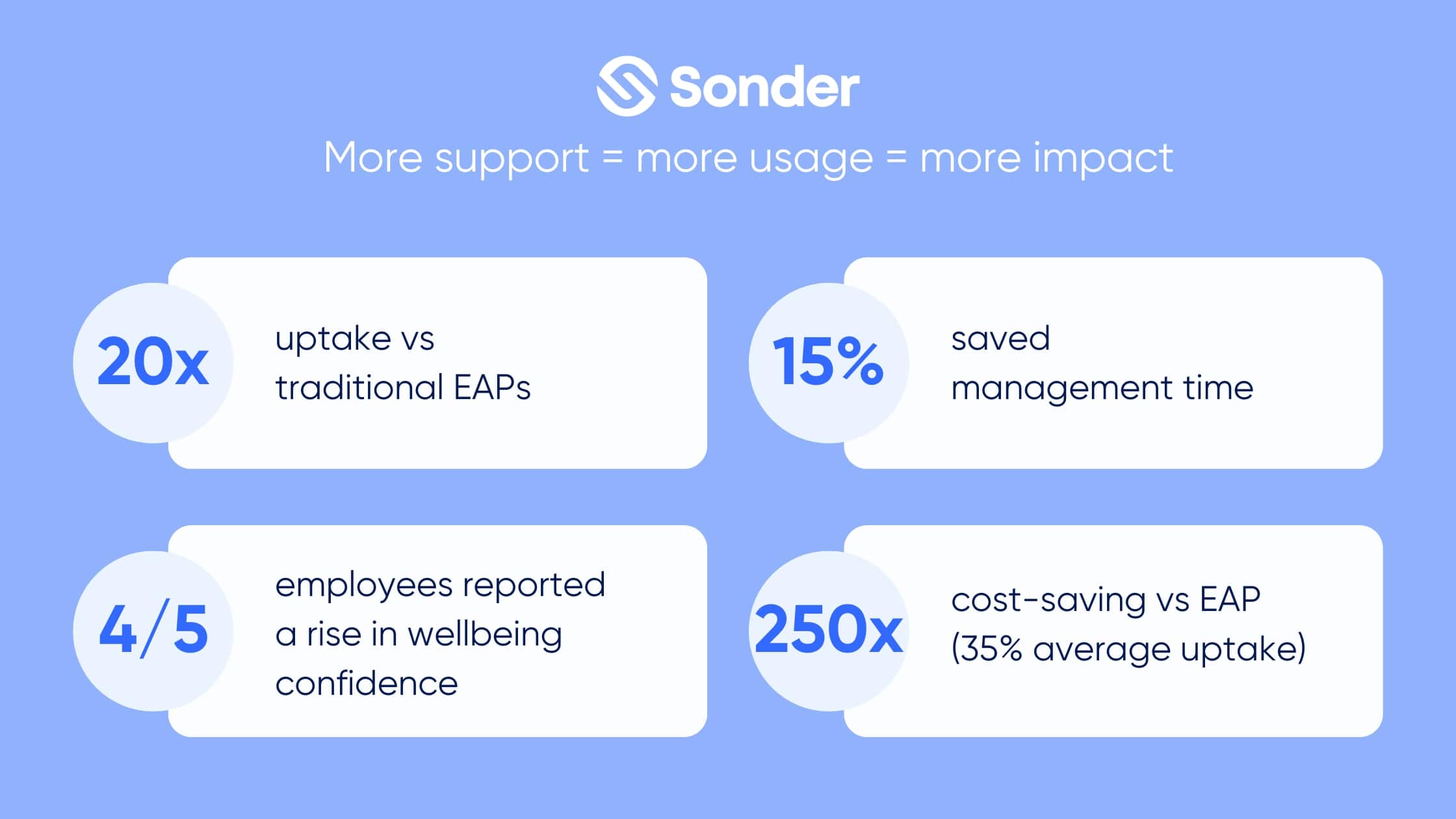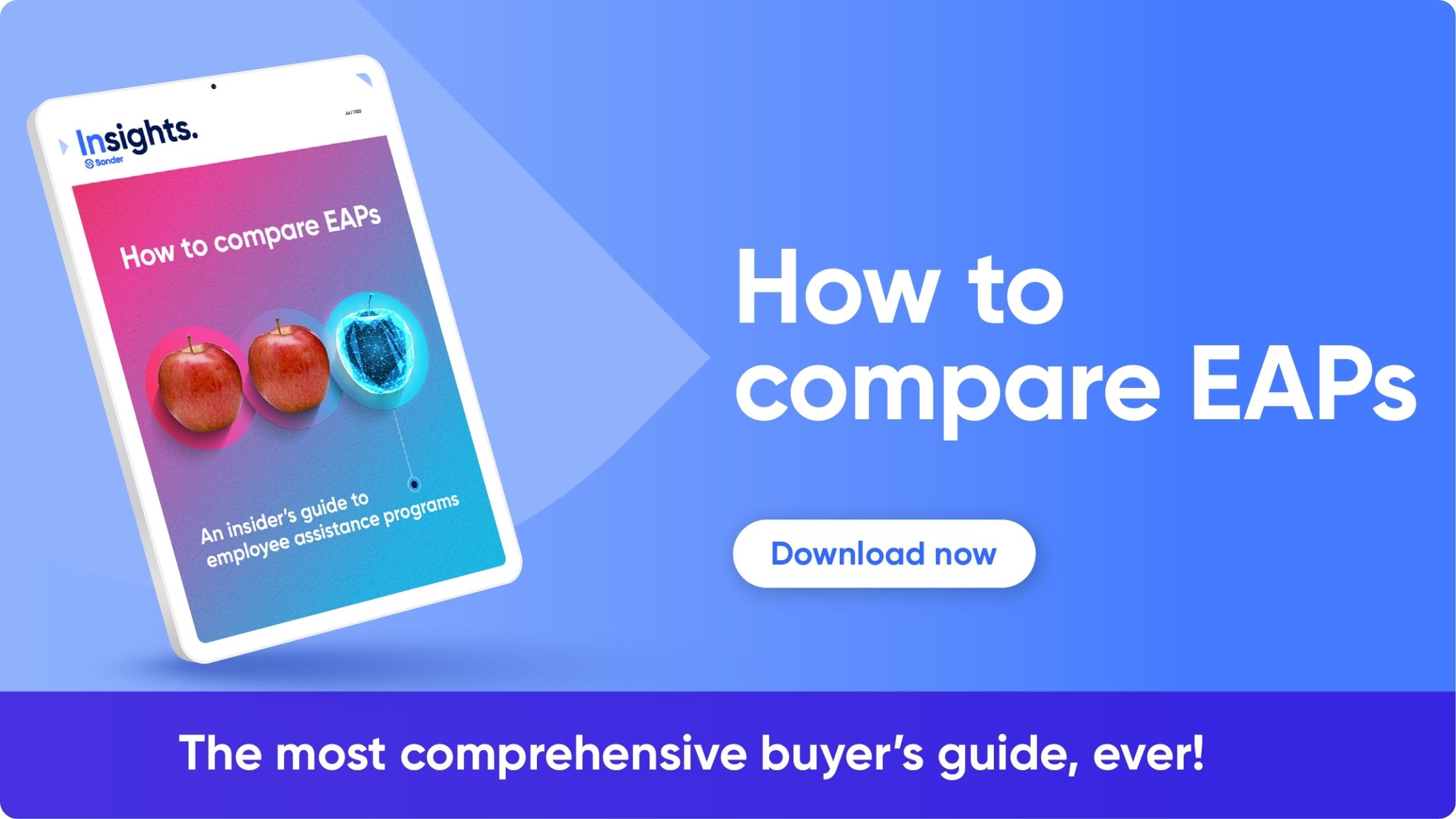The TL;DR:
- There are four common EAP types: external EAPs, internal EAPs, embedded EAPs, and alternative EAPs (like Sonder).
- By weighing up the pros and cons of each EAP type, leaders can make an informed decision about which program delivers the right balance between affordability and scope of care.
- If your company is looking for proactive, preventative care that looks at your people holistically, it’s worth exploring EAP alternatives that go beyond mental health support and also offer medical and safety services, too.
Employers need to do more than offer a handful of counselling sessions to meet the growing expectations of employees. With a variety of employee assistant program (EAP) types to choose from, it’s important to learn how to accurately compare your options.
EAPs are offered by 80% of Australia’s top 500 companies and 74% of UK workers are covered by some kind of EAP. But, the average utilisation rate for EAP services across Australia, the UK and the US is incredibly low at just 5%.
There are a number of factors that limit the effectiveness of EAPs, from a lack of awareness of what services are available, to limited coverage, and even concerns around quality, privacy and confidentiality.
As a leader, you’ll want to be sure you are selecting the right type of EAP to support your people. By weighing up the pros and cons of each EAP type, you can make an informed decision about which program delivers the scope and scale of support needed for your organisation to thrive.
Type one: External EAPs
Many companies engage third-party service providers to bring their employee assistance programs to life. Known as external EAPs, this approach means multiple organisations are contracted to offer everything from mental health counselling to financial advice and beyond.
When it comes to traditional EAPs, working with external providers is the preferred option for companies for a couple of reasons. Firstly, companies can handpick the exact services they’d like to offer to keep costs down. Plus, external EAPs are easy to scale as a company or team grows, too.
To access an external EAP, employees will need to know what service providers they have access to, how to book an appointment and what level of support they’re entitled to. This puts the onus on HR teams to educate employees about the scope of the company’s external EAP offering.
Pros of External EAPs
- External EAP providers provide specialised, niche support services in a safe, confidential environment.
- External EAPs can be more affordable, with companies only paying for the third-party service providers their team needs.
- External EAPs operate separately from an employee’s company, helping to alleviate any privacy concerns that may cause employees to avoid seeking support when they need it.
Cons of External EAPs
- Employees may not know what service providers they have access to, leading to low utilisation rates.
- Support tends to be siloed and may be limited to a specific number of sessions or a period of time.
- More established external EAP providers tend to require a minimum headcount, meaning smaller companies may struggle to access the support they need.
- Often scope is limited to mental health support only, with no medical or safety features offered.
Type two: Internal EAPs
On the flip side, internal EAPs involve bringing these service providers in-house. With internal EAPs, counselling and wellbeing services are provided by internal staff-rather than external third-party providers.
For larger companies, building out a team of mental health specialists, psychologists, counsellors, and financial advisers can be possible. However, for smaller businesses, the costs of hiring for a number of new roles will likely be a hefty investment.
In some cases, internal EAPs involve upskilling existing team members (such as managers or HR professionals) to offer these services. However, this can present challenges in terms of effectiveness and fostering a safe space for employees to share their concerns openly.
Pros of Internal EAPs
- Internal EAPs allow for greater flexibility, allowing companies to customise the services offered to employees based on their needs.
- Internal EAPs can offer a better continuity of care, with employees receiving support from the same familiar face in their team.
- Internal EAPs can lower the barriers to access, with employees able to seek support from another team member in their own office.
Cons of Internal EAPs
- Due to the high costs of internal hiring, the scope of care may be limited with an internal EAP, as it won’t be feasible to hire a dedicated resource for each support area.
- If an internal EAP relies on upskilling existing team members, there can be questions about the quality of care (as managers may be asked to step up and assume responsibilities outside their core capabilities).
- Uptake can be lower as employees may hesitate to voice their concerns, or worry about confidentiality, with an internal employee.
Type three: Embedded EAPs
In some cases, companies may have their EAP services bundled into existing subscriptions or healthcare plans. As the name suggests, embedded EAPs mean these services are added to things like your company’s health insurance policy as a perk for employees.
While it may feel ‘free’, the costs of embedded EAPs are covered in your other subscriptions or service fees.
As you can imagine, there are a number of drawbacks to embedded EAPs. Not only does the scope tend to be very limited, but the company has no say over what services they gain access to. Plus, some embedded EAPs may only offer discounts for support services (such as reducing the cost of a gym membership or lowering the costs of seeing a financial adviser).
Pros of Embedded EAPs
- Embedded EAPs make it easy for companies to offer some level of support to employees without having to make an additional investment.
- Embedded EAPs are automatically ‘added on’ by service providers, reducing hassle and manual work for companies in setting up an EAP.
Cons of Embedded EAPs
- Embedded EAPs tend to be an afterthought, not the main product, which can mean a lower quality service with a lack of coverage.
- Embedded EAPs also give companies access to fewer services and may lack the specialist expertise your team needs.
Type four: EAP alternatives
As you can tell, there are several drawbacks to consider across all types of traditional EAPs. That’s why modern alternatives, like Sonder, are offering a new way for companies to boost retention, lower absenteeism and increase productivity.
Unlike traditional EAPs, Sonder’s active care platform offers comprehensive coverage across medical, safety and mental health support. We know that 72% of Sonder cases include at least two underlying issues, meaning mental health counselling alone isn’t enough to help your people perform at their best.
With more comprehensive support coverage, a 24/7 mobile app for always-on support and the scope to include partners and immediate family members, it’s no wonder the Sonder achieves a significantly higher utilisation rate than traditional EAP types.

In practical terms, here’s how Sonder’s complete employee care platform works:
- Medical advice from health professionals: Registered nurses, accessible via the app, save employees sleepless nights and houses wasted in emergency waiting rooms.
- Chat to a specialist care team 24/7: Rather than limiting care to business hours, employees can chat with a specialist in 10 seconds or less via chat or phone calls.
- Access one-touch personal safety tools: Make sure your team feels safe when they’re travelling for work or on-to-go with smart alerts and self-managed safety tools.
- Receive in-person support for critical incidents: Sonder’s team is spread nationwide, with responders able to be on the scene in most metro areas within 30 minutes (and within two hours in rural locations).

In a recent webinar, Katie Thompson, HUB24’s People and Culture Advisor, shared their story on making the switch from the previous EAP to Sonder.
“Sonder has created a framework for us that, no matter where you sat in the business, you were able to get support. It’s very different from a traditional EAP service. It’s a holistic model of care.”
Katie Thompson
HUB24’s People and Culture Advisor
The way forward with Employee Assistance Programs and their alternatives
Want to learn more? Dive deeper into the world of EAP alternatives and discover how they can transform your organisation with our ultimate EAP buyer’s guide.
- Learn how to compare vendor offerings
- Discover what makes EAP alternatives different
- Gain insider tips and statistics
- Write a convincing business case

Want to learn more?
Ready to experience a modern approach to employee care? Get in touch with Sonder today to discover how our platform can benefit your organisation.



